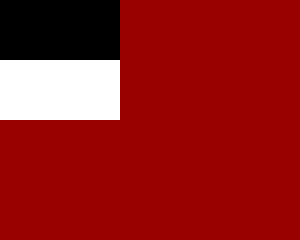Western Heraldry In Modern Georgia – Analysis
By Prof. Dr. Tedo Dundua and Dr. Emil Avdaliani
Besides serving as national symbols, flags also say a lot about the values of a country.
For millennia flags have served as national symbols. They also serve as a form of communication. But most of all they serve as a form of identification as the colors and symbols of each flag convey a certain idea or ambitions. It also says a lot about values of a country.
Georgia has had several flags throughout its history, and it is interesting how each flag reflected the country’s geopolitical ambitions (preferences in alliances etc.).

For instance, the national flag of the first republic of Georgia in 1918-1921 was a tricolor resembling the colors of the German Empire.
The resemblance was not accidental – Georgia was pro-German at the time and hoped for Berlin’s victory in the World War I.
Georgia’s current flag also reflects the national values and geopolitical aspirations. It features Crusading states’ “Cross of Jerusalem”, derived from “Cross Potent”, which was an important heraldic feature of the Byzantine Empire.
“Cross Potent”

“Cross Potent” is often shown in the Byzantine numismatics since Emperor Tiberius II (578-582) (David R. Sear. Byzantine Coins and Their Values. London. 1996, p. 14). “Cross Potent” was widespread in the entire Christian world, even being used by various seigniors in the Western Europe. “Cross Potent” also features on the silver money of the Georgian seignior David III Kuropalates (+1001) http://geonumismatics.tsu.ge/en/catalogue/types/?type=40
Quite often in the quarters of the cross the Byzantines put the following religious legend: IC-XP NI-KA.

Later on, occasionally, instead of legends, stars were put in quarters of “Cross Potent”. A star was one of the attributes of Constantinople’s heraldry.
In the age of Crusades the Western Europe gave a different interpretation to the “Cross Potent” by adding four crosses in quarters. This is already “Cross of Jerusalem. The identical combination is seen even on the 18th c. coat of arms of the Kingdom of Sardinia (X. Фенглер, Г. Гироу, В. Унгер. Словарь нумизмата. Берлин-Москва. 1982. Article «Иерусалимский крест», p. 98.).

“Cross of Jerusalem” was the symbol of integration of the Western Europe, created in the era of Crusades.
As in most cases, Georgia’s flags, whether historical or modern one, reflect the country’s foreign policy preferences and its national aspirations. The five-cross flag thus shows how Georgia sees herself – increasingly as a part of Europe.
*Prof. Dr. Tedo Dundua, Dr. Emil Avdaliani, Institute of Georgian History, TSU

